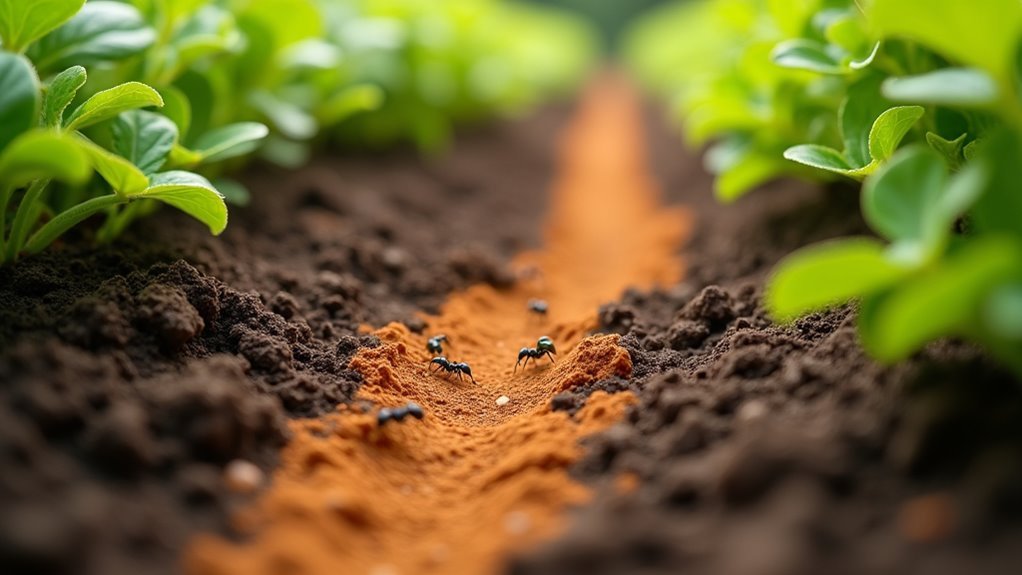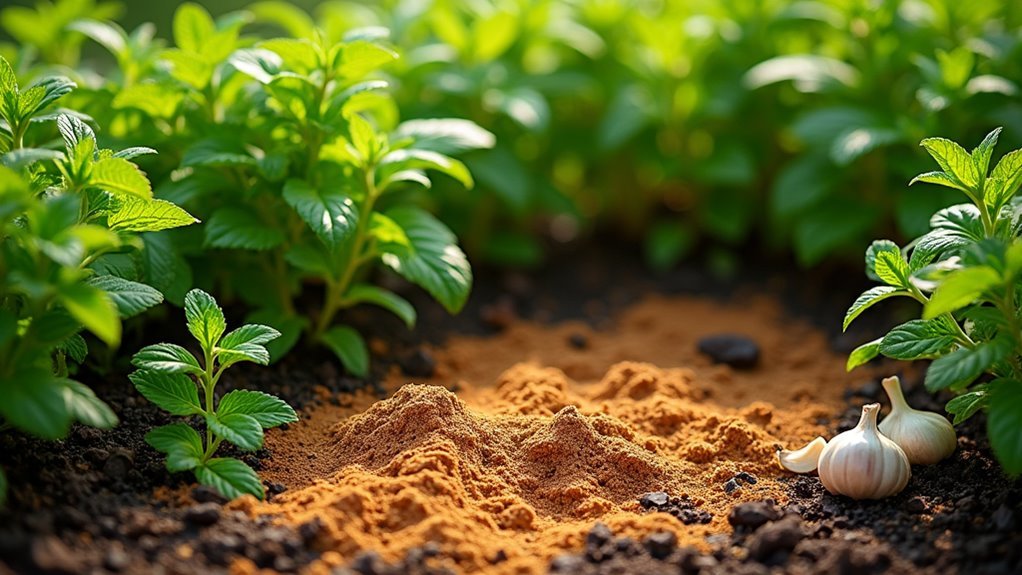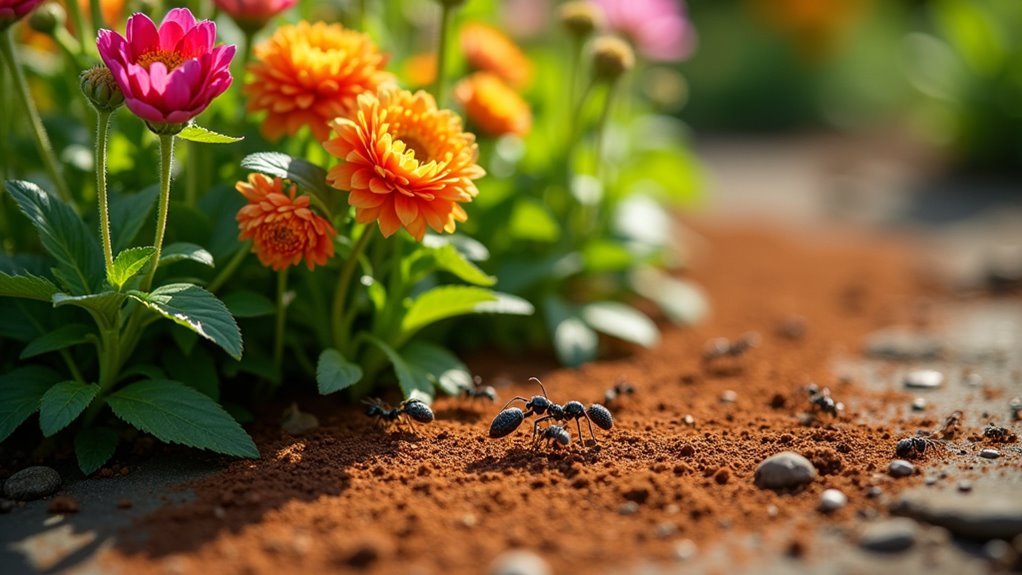You can repel ants from garden beds by sprinkling ground cinnamon around plant perimeters, creating natural barriers that disrupt their pheromone trails. Ceylon cinnamon works better than cassia varieties due to higher concentrations of cinnamaldehyde. For enhanced effectiveness, combine ground cinnamon with essential oil sprays or mix it with diatomaceous earth. Reapply every two weeks or after rainfall to maintain protection. This thorough approach will help you discover additional strategies for long-term ant management success.
Understanding Ant Behavior in Garden Spaces

When you spot ants marching through your garden, they’re likely following invisible chemical highways called pheromone trails that lead them to food, water, or shelter.
These persistent foragers don’t randomly wander—they’re systematically searching for resources while creating efficient pathways between their colonies and discovered treasures in your garden beds.
Before you declare war on these tiny invaders, consider their potential benefits. Many ants actually help your garden by aerating compacted soil through their tunneling activities and controlling harmful pest populations that damage plants.
Some species even serve as pollinators, transferring pollen between flowering plants as they forage for nectar.
Understanding which ant species have taken residence in your garden spaces helps you decide whether to manage their populations or embrace their presence as beneficial garden allies.
The Science Behind Cinnamon as a Natural Deterrent
Although ants rely heavily on chemical communication to navigate your garden, cinnamon’s active compound cinnamaldehyde disrupts these invisible highways by interfering with their pheromone trails.
When you sprinkle ground cinnamon around entry points, you’re fundamentally scrambling their GPS system, making it difficult for scout ants to guide others to food sources.
However, there’s a significant difference in effectiveness between products. Cinnamon essential oil contains concentrated levels of cinnamaldehyde that laboratory studies show can successfully repel ants.
Laboratory studies confirm that cinnamon essential oil’s concentrated cinnamaldehyde levels deliver significantly more effective ant repellent properties than standard grocery store varieties.
In contrast, the lower concentrations found in grocery store cinnamon won’t provide long-term deterrence. While ground cinnamon creates temporary barriers that redirect ant traffic, it doesn’t eliminate what’s attracting them.
You’ll achieve better results combining cinnamon with thorough pest management strategies.
Types of Cinnamon and Their Effectiveness Against Ants

When you’re shopping for cinnamon to repel ants, you’ll encounter two main varieties that differ markedly in their pest-fighting power.
Ceylon cinnamon, known as “true cinnamon,” contains higher concentrations of the active oils that send ants packing, while the common Cassia cinnamon found in most grocery stores offers weaker repellent properties.
You’ll get better results by choosing Ceylon over Cassia, but the concentration of active compounds in whichever type you select will ultimately determine your success in keeping ants away.
Ceylon Vs Cassia
Ceylon cinnamon packs higher concentrations of beneficial compounds that actually disrupt ant trails and keep them away from your garden beds.
Laboratory studies confirm its superior effectiveness compared to the common Cassia variety. While Cassia might smell nice, it won’t solve your ant problem.
For best results, use pure Ceylon cinnamon essential oil mixed with a carrier rather than sprinkling ground cinnamon.
It’s safer for your plants, more potent against pests, and environmentally friendly.
Concentration Levels Matter
Since not all cinnamon is created equal, you’ll need to pay close attention to concentration levels when choosing your ant-repelling arsenal. The effectiveness of cinnamon against ants depends heavily on the concentration of active compounds present in your chosen form.
Laboratory studies show that concentrated cinnamon oil demonstrates considerably stronger insecticidal properties than powdered varieties.
Here’s how concentration affects your ant control success:
- Grocery store cinnamon powder – Contains minimal essential oils, making it less effective for pest control
- High-quality Ceylon cinnamon – Offers better concentration than standard Cassia varieties
- Cinnamon oil concentrate – Provides maximum potency with higher active compound levels
- Diluted cinnamon oil mixture – Balances effectiveness with practical garden application needs
For best results, choose cinnamon oil mixed with water rather than relying on ground spices alone.
Step-by-Step Application Methods for Garden Bed Barriers
You’ll achieve maximum ant deterrence by applying cinnamon barriers using three distinct methods that work together to protect your garden beds.
Start with ground cinnamon for creating perimeter lines. Then enhance protection with essential oil sprays for harder-to-reach areas.
Finally, place cinnamon sticks strategically throughout your garden beds to maintain long-lasting coverage and visual appeal.
Ground Cinnamon Barrier Lines
When ants consistently invade your garden beds, creating ground cinnamon barrier lines offers an effective, natural defense strategy.
You’ll establish protective perimeters that discourage ant movement while maintaining your garden’s health.
Follow these steps to create effective ground cinnamon barrier lines:
- Identify entry points – Observe where ants typically enter your garden beds and mark these high-traffic areas for targeted application.
- Sprinkle cinnamon perimeter – Create continuous lines of ground cinnamon around garden bed borders, paying special attention to identified entry points.
- Reapply regularly – Refresh your cinnamon barriers every few weeks or immediately after rain to maintain potency.
- Clean surrounding areas – Remove food sources and debris near barriers to prevent attracting ants despite your deterrent efforts.
Essential Oil Application Methods
While ground cinnamon provides solid protection, cinnamon essential oil delivers a more concentrated and longer-lasting solution for garden bed barriers. You’ll get superior ant-repelling power compared to cinnamon powder alone.
| Application Method | Materials Needed | Frequency |
|---|---|---|
| Spray Solution | 10-15 drops oil + 1 cup water | Every few weeks |
| Direct Application | Cotton swab + essential oil | As needed |
| Barrier Placement | Whole cinnamon sticks | Monthly replacement |
| Targeted Treatment | Oil-soaked cotton balls | Weekly monitoring |
Create your spray by mixing 10-15 drops of cinnamon essential oil with one cup of water in a spray bottle. For pinpoint accuracy, dip cotton swabs directly into the oil and apply to high-activity areas. Reapply after rainfall to maintain effectiveness, and monitor ant activity regularly to adjust your application frequency.
Cinnamon Stick Placement Strategy
Where should you position cinnamon sticks for maximum ant-deterring impact? Your cinnamon stick placement strategy requires careful consideration of ant behavior patterns and garden layout.
Focus on creating continuous barriers that block common entry routes while targeting high-activity zones.
Follow this systematic approach:
- Create perimeter barriers – Place whole cinnamon sticks around garden bed edges, spacing them closely together to eliminate gaps where ants might slip through.
- Target active areas – Position sticks directly on visible ant trails and near garden entryways where you’ve observed frequent activity.
- Maintain regular replacement – Swap out sticks after rainfall or every two weeks to preserve their deterrent strength.
- Combine with other deterrents – Layer cinnamon sticks with diatomaceous earth or bay leaves for enhanced protection effectiveness.
Creating Effective Cinnamon Perimeters Around Vegetables
Although ants can quickly overwhelm vegetable gardens, you’ll find that establishing a strategic cinnamon perimeter offers an effective defense against these persistent invaders.
Use cinnamon by sprinkling thin lines of powdered cinnamon along entry points and pathways where you’ve spotted ant activity. For stronger protection, create a spray solution by mixing cinnamon essential oil with water, then apply it around your garden bed borders.
Place whole cinnamon sticks at strategic locations throughout your garden as natural barriers while ensuring easier cleanup than powder.
You’ll need to reapply cinnamon regularly, especially after rainfall, to maintain effectiveness. Monitor your perimeter consistently, checking that the cinnamon barrier remains intact and adjusting application based on ongoing ant activity levels.
Combining Cinnamon With Other Natural Ant Repellents

When you combine cinnamon with other natural ant repellents, you’ll create a more powerful defense system that targets ants through multiple mechanisms.
Here are four effective combinations to enhance your cinnamon defense:
- Cinnamon and White Vinegar Spray – Mix these together for a potent spray that uses vinegar’s strong scent while cinnamon disrupts ant trails.
- Cinnamon with Diatomaceous Earth – Sprinkle food-grade diatomaceous earth alongside cinnamon to create a dual-layer barrier that repels and dehydrates ants upon contact.
- Enhanced Cinnamon Essential Oil Spray – Add dish soap to your cinnamon oil and water mixture for better surface adhesion and stronger repellent effects.
- Cinnamon and Bay Leaves – Place bay leaves with cinnamon around garden beds to utilize ants’ natural aversion to bay’s scent.
Maintaining Your Cinnamon Barriers Throughout the Season
Creating powerful cinnamon combinations gives you an excellent foundation, but your ant defense system requires consistent maintenance to stay effective throughout the growing season.
You’ll need to reapply your cinnamon barriers every two weeks or immediately after rainfall to maintain their potency. Monitor your garden regularly for ant activity and refresh applications wherever you spot them to disrupt their established trails.
Track your garden’s conditions carefully, as excessive moisture or abundant food sources will require more frequent barrier renewals.
Combine ground cinnamon with cinnamon essential oil for maximum effectiveness, ensuring you maintain consistent coverage around all entry points.
Integrate this maintenance schedule into your regular gardening routine alongside other natural repellents for thorough pest management throughout the season.
Troubleshooting Common Challenges With Cinnamon Ant Control
Even with proper maintenance, you’ll likely encounter situations where your cinnamon barriers don’t perform as expected. Understanding these common challenges helps you adjust your approach for better results.
Common Cinnamon Ant Control Issues:
- Low potency cinnamon – Grocery store cinnamon often lacks sufficient concentration to eliminate ants permanently, only redirecting them temporarily to different entry points.
- Ignoring attraction sources – You’re treating symptoms rather than causes if you don’t address food scraps, standing water, or moisture that draws ants initially.
- Inconsistent reapplication – Rainfall and weather reduce cinnamon’s effectiveness, requiring frequent monitoring and fresh applications to maintain deterrent properties.
- Single-method approach – Combining cinnamon with diatomaceous earth or vinegar creates more thorough pest management than relying on cinnamon alone.
Frequently Asked Questions
Does Cinnamon Keep Ants Out of Your Garden?
Cinnamon provides limited ant deterrence in your garden. You’ll find grocery store cinnamon lacks concentration for effective repelling. You’ll get better results using concentrated cinnamon essential oil while addressing underlying food and moisture sources.
How Do I Keep Ants Out of My Garden Bed?
You’ll want to remove food sources and debris that attract ants first. Then sprinkle powdered cinnamon around your garden’s perimeter or spray cinnamon essential oil mixed with water on active areas.
Can I Sprinkle Cinnamon in My Garden?
You can sprinkle cinnamon in your garden safely. It won’t harm your plants and actually provides antibacterial benefits to soil. Apply it around garden beds and reapply after rain for continued effectiveness.
How Long Does It Take for Cinnamon to Kill Ants Outside?
Cinnamon won’t kill ants outside – it only acts as a temporary deterrent. You’ll need to reapply frequently after rain or watering, and ants will simply find alternative routes around the cinnamon barrier.
In Summary
You’ve now got the knowledge to effectively use cinnamon as a natural ant deterrent in your garden beds. Remember that consistency is key—you’ll need to reapply cinnamon regularly, especially after rain or watering. Don’t hesitate to combine it with other natural repellents for better results. With patience and persistence, you’ll create ant-free garden spaces while avoiding harsh chemicals that could harm your plants or beneficial insects.





Leave a Reply